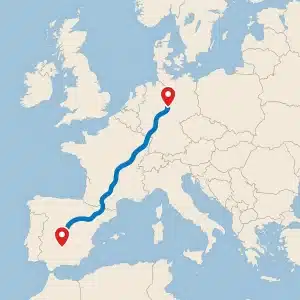
Import a car from Germany in 2025: costs, steps and how to make it easy
Import a car from Germany has become a very popular option for buyers seeking a well-equipped nearly new vehicle at a competitive price. The German market offers a huge variety of models with verifiable service histories (Scheckheft) and rapid depreciation—especially on premium cars—creating genuine bargains. In addition, there are incentives and tax advantages for companies, freelancers and for the purchase of electric or classic vehicles.
How much does it cost to buy a car in Germany?
This section includes the price negotiated with the seller, local fees for the transaction and provisional registration, plus the temporary export plates (Kurzzeitkennzeichen) that allow you to drive in Germany and other EU countries. It also covers the compulsory short-term insurance for these plates, whose cost varies with the chosen duration and cover.
How to bring the car from Germany to Spain
The transfer can be done in two main ways: driving the vehicle yourself from Germany—meaning export plates, fuel and trip costs (accommodation, meals, tolls)—or hiring a company specialised in car transport.
The truck-transport price can vary according to several factors, such as the distance between the pick-up point in Germany and the delivery point in Spain, the type of vehicle, the urgency of the service or route availability. Other aspects also matter, like exact delivery to a specific address or the need for intermediate pick-up/delivery points.
The taxes you’ll pay when registering your car in Spain
On arrival in Spain you must consider several taxes: intra-EU VAT (in certain cases), the Special Tax on Certain Means of Transport (IEDMT) whose amount depends on the vehicle’s emissions level, and the administrative fees charged by the DGT for issuing the final plates.
Real-world budget examples: how much will you spend?
- Compact car: the extra cost for purchase, transport, taxes and registration is roughly €1,500 – €2,500 above the car’s price.
- Premium SUV: this type of vehicle usually requires a higher additional outlay, estimated at €2,500 – €4,000.
Step by step: from finding your ideal car to having it at home
1. Search and verification
The first stage is to look for the ideal vehicle. Platforms such as Mobile.de or AutoScout24 offer a wide range of choices. It is essential to carry out a thorough check of the car’s history, reviewing the TÜV technical report, the service book (Scheckheft) and any possible mileage inconsistencies.
2. Purchase in Germany
Once you have chosen the vehicle, negotiate with the seller and formalise the purchase through a (Kaufvertrag) contract that clearly sets out every detail of the transaction. Secure SEPA transfers are recommended to keep an official payment record and avoid the risks of cash.
3. Logistics and transport
After purchase, the logistics phase begins: moving the vehicle from Germany to your residence in Spain. This requires correctly handling the German documents Teil I and Teil II, equivalent to the registration certificate and circulation permit, indispensable for proving ownership and for the later procedures in Spain.
Option A: Drive it yourself
Driving the vehicle yourself appeals to those who want the experience or to reduce initial costs. You must request export plates (Kurzzeitkennzeichen or Zollkennzeichen) and plan the trip (route, tolls, fuel, accommodation). In case of a breakdown or accident, all responsibility lies with the buyer.
Option B: Hire truck transport
The most comfortable and safest alternative is to hire a specialised company that uses an open truck. This door-to-door service avoids mechanical or weather-related problems and lets you focus on other formalities in Spain.
Although driving yourself may seem cheaper at first, professional transport usually pays off thanks to its peace of mind, safety and time savings. In our case we also streamline the whole process, handling all paperwork and Spanish registration for you. Request a free quote with no obligation.
4. Paperwork and registration in Spain
Once in Spain, the vehicle must meet certain administrative requirements. You will need a reduced technical sheet or Certificate of Conformity (COC), pass the import ITV, pay the relevant taxes (form 576) and finally complete the procedures with the DGT to obtain the definitive Spanish plates.
DIY or hire an expert? Pros and cons
Handling the entire import process yourself can be economical but requires time, specific knowledge and risk management. A professional importer saves time and complications, ensuring a safer and smoother procedure. Evaluate both options according to your needs.
Tips and risks when importing: how to avoid unpleasant surprises
Always watch out for fraud such as mileage tampering, altered documents or unsafe payment methods. Verify all information and use secure payments. Know your EU legal guarantees to protect yourself against hidden defects.
Frequently Asked Questions (FAQ)
How long does the whole import process take? Generally 1 – 3 weeks, depending on the transport method, vehicle availability and the speed of the paperwork.
Are there hidden costs? Besides the purchase and transport, consider administrative fees, taxes such as IEDMT, temporary insurance and any agency handling charges.
Can I import electric vehicles from Germany with tax benefits? Yes, electric vehicles often receive full or partial IEDMT exemptions and additional local benefits.
Do I need to travel to Germany to buy and import the car? Not necessarily. Although travelling lets you inspect the vehicle personally, the whole process can be managed remotely with professional services.
What should I do if I find problems after import? Keep all documentation and contact the seller. If necessary, seek legal advice—EU regulations protect you against hidden defects.
How can I find out the exact cost of shipping my vehicle from Germany? Request your free quote here with no obligation.



